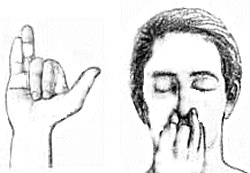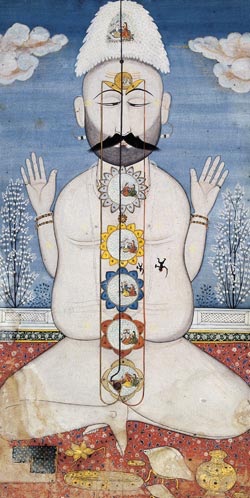Uniting The Sun and The Moon- Monthly practice for April
Individual practices for each sign and HOROSCOPES are here
Practice this month - Nadi Shodhana (Channel Clearing Breath)
Nadi Shodhana is a form of pranayama, or breathing practice. Any breathing practice should be undertaken first with absolute ease and non-attachment to outcome. If you find yourself feeling stressed or anxious then cease immediately and just let yourself breathe without any restriction. One of yoga's most important teachings is that prana (breath) controls chitta (mind). The potency of breathing practices is that they can clear and calm your mind, but they also have the power to greatly upset your mind if they're undertaken with too much force, so approach them as you would any aspect of your meditation practice; with friendliness, patience, and a good sense of humor. And if things don't feel right, don't do them.
It's also important to have clear nostrils for this practice. With spring's arrival consider spring cleaning your internal space as well as your external spaces. Eating lighter, less mucus-producing foods, use of a neti pot, and inclusion of local herbs to counteract environmental allergens will all be beneficial in opening and clearing your sinuses. For inspiration on internal spring cleaning check out Jaysen Paulson's article on herbal remedies for this month.
The purpose of Nadi Shodhana is to clear and balance your nadis. Nadi means 'channel' in Sanskrit, and their function is to transport prana, or life force through the body. Eastern elemental medicines such as Ayurveda and Traditional Chinese Medicine both work with 'channels' that move prana (chi in Chinese Medicine) through your body. These channels aren't nerves, but function somewhat similarly in that they work like a circuit that is balanced through polarity and sends life force and information into your body from your brain/mind and from your body back to your brain. According to Tantric philosophy there are some 72,000 nadis that run through the human body, but only three of these channels are of supreme importance; these are called Sushumna, Ida and Pingala. Sushumna refers to the central most energetic pathway that forms your vertical axis, it is said to run just in front of the spine. Ida and Pingala are the two channels that circulate prana along the right and left sides of the spine. They begin coiled together at the base of the spine and criss-cross at the chakra centers as they ascend towards the head. Ida refers to the feminine principle and is sometimes translated as Chandra, or Moon. Ida begins on the left side of the spine and eventually rises to energize the right side of the brain. Pingala refers to the masculine principle and is sometimes translated as Surya, or Sun. Pingala begins on the right side of the spine and eventually rises to energize the left side of the brain.
It's important to note that Ida and Pingala, are energetic notions of feminine and masculine, and do not have to do with gender or sex as we commonly think about them. Feminine and Masculine energies, also called Yin and Yang, exist in all creation and all bodies. Some feminine principles that exist in our bodies and in nature include qualities that are receptive, cool or cold temperature, instinctual, emotional, creative, nurturing, downward/earthward moving, and inwardly-focused. Some masculine principles include qualities of assertion, aggression, directionality, warmth and heat, logical, rational, structured, desirous, upward/heavenward moving and outwardly-focused.
Hatha Yoga literally means 'meeting of the sun and the moon'. Through all of our efforts in yoga we are ideally working towards balance. We become imbalanced when we have too much feminine or masculine effort. A good example of this is the difference between a 'yin' style practice that is more cooling, relaxing, and inwardly-focused, and a 'yang' style practice that is more dynamic, heating, and outwardly-focused. But even within these styles we must try and balance ourselves between attention and intention; inhale and exhale; effort and ease. The many aspects of yoga practice all call our attention to imbalance; as we become more adept in our practices we learn to let go where we are efforting too much, to fortify where we are lazy or weak, and to be in a place of sensitivity that allows us to observe our fluctuations with compassion.
Nadi Shodhana works directly with the energetic spaces where these energy centers live and so therefore can be an extremely beneficial practice to include regularly! Again though, practice with ease in your heart and mind. Remember that you're working to balance both receptivity and effort. If you get too effortful you will strain yourself and this practice will be more damaging than healing. Also if you space out and become lazy in your attention it's probably not worth it. So be honest, attentive, present and have fun! Here's how to do it:
1.) Sit in a comfortable position that you can maintain for at least 10 minutes without needing to fidget or readjust 2.) Take a minute or so to center yourself. Close your eyes, feel you body, and without doing anything to change it, just notice your breathing. 3.) Start to breathe in a measured fashion. It's helpful to find a count for your breath- notice how long it takes you to inhale comfortably and then match that length with your exhale. Breath like this for a minute or two. 4.) Bring the index and middle finger of your left hand into your palm. Use your fourth finger and thumb to lightly hold either nostril just below the cartilege at the bridge of your nose.
5.) The breathing practice goes like this:
- After an exhale through both nostrils, lightly close the right nostril and inhale through the left. At the top of your inhalation hold your breath for a second as you close both nostrils. Open the right nostril and exhale. At the completion of your exhale pause with the right side still open. Inhale through your right nostril. At the top of your inhalation lightly close both nostrils and hold your breath for a second. Open the left nostril and exhale. At the completion of your exhale pause with the left side still open. Open the left nostril and exhale. At the completion of your exhale pause with the left side still open.
This is one round, repeat the above instructions for at least 10 rounds or continue as long as you like. When you are ready to finish, finish with an exhale to the left side and then sit for a minute or so longer with even steady breaths through both nostrils



